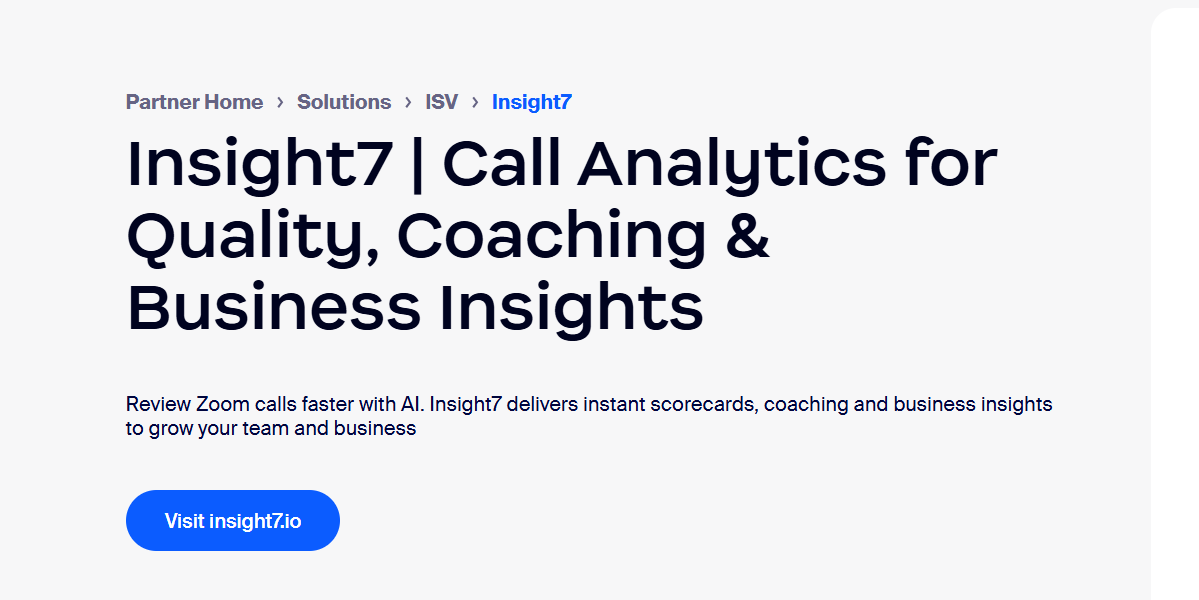How to Report on Agent Performance Without Demoralizing Teams
-
Bella Williams
- 10 min read
Supportive performance feedback is essential for maintaining a motivated workforce, especially when reporting on agent performance. Often, performance reviews can feel like a critique rather than an opportunity for growth, leading to demoralization among teams. By cultivating a culture that emphasizes guidance and support, organizations can promote an atmosphere that encourages continuous improvement.
In this section, we will explore how supportive performance feedback can be effectively integrated into performance reports. This approach not only fosters a more positive environment but also drives agents to excel. By emphasizing constructive and actionable insights, managers can ensure that feedback is perceived as a pathway to development rather than a source of discouragement.
Analyze & Evaluate Calls. At Scale.

Creating a Culture of Supportive Performance Feedback
Creating a culture of supportive performance feedback is essential for uplifting team dynamics and enhancing engagement. To foster this environment, it is crucial to communicate openly and consistently about performance expectations. Employees thrive when they understand what success looks like, making it easier for them to meet organizational objectives. Moreover, integrating regular feedback sessions helps establish trust between team members and management, encouraging a mutually respectful dialogue.
In implementing supportive performance feedback, employing constructive techniques is vital. Instead of singling out failures, focus on areas for growth and celebrate successes. Encourage team members to share their perspectives on their performance, creating a sense of ownership in their development. This two-way feedback process not only motivates individuals but also promotes a collaborative atmosphere where everyone feels valued and heard. By nurturing this culture, teams can achieve higher morale and improved performance outcomes.
Establishing Clear Objectives
Establishing clear objectives is essential in creating a framework for monitoring agent performance without causing demotivation. When agents know precisely what is expected of them, they can focus their efforts on achieving those targets. Clear and specific objectives act as a guide, helping teams understand how their contributions fit within broader organizational goals. This clarity fosters a sense of accountability and encourages a positive work environment.
Furthermore, these objectives should be realistic and attainable to ensure agents feel equipped to succeed. By involving team members in the goal-setting process, their input can foster ownership and commitment. Regular check-ins can help assess progress, allowing for timely adjustments and aligning support with individual needs. Overall, a clear objective setting, rooted in supportive performance feedback, enhances team dynamics and promotes ongoing development. This is vital for maintaining morale and sustaining motivation within the team.
Employing Constructive Feedback Techniques
To effectively employ constructive feedback techniques, it’s crucial to approach the process with sensitivity and a focus on growth. Supportive performance feedback is most impactful when it highlights both strengths and areas for improvement. Begin by observing and documenting specific behaviors that contribute positively or negatively to performance. These examples give context, making feedback clear and actionable.
Next, engage in open dialogue with team members. Frame discussions around shared goals and aspirations, encouraging agents to express their thoughts on their performance. This collaborative approach fosters trust and reinforces a culture of continuous improvement. Rather than simply pointing out mistakes, emphasize what employees are doing well. This balance helps maintain morale and motivates teams to strive for excellence. Constructive feedback becomes a powerful tool not only for individual growth but also for enhancing overall team performance.
[optional: include tools section here]Step-by-Step Guide to Implement Supportive Performance Feedback
To implement supportive performance feedback effectively, start with clear, achievable goals for each team member. By establishing these goals, agents will understand what is expected of them and feel a sense of ownership over their progress. The clarity provided by well-defined objectives fosters an environment where constructive feedback becomes a natural part of professional development.
Next, it's crucial to use data to inform the feedback process. Analyze performance metrics, such as call evaluations and customer interactions, to provide insight. This enables you to discuss specific instances of success or areas needing improvement, making the feedback both relevant and actionable. Finally, make sure to develop personalized growth plans that align with individual strengths and areas for improvement. By fostering a culture of continuous growth and open communication, teams can thrive and feel valued in the workplace.
Extract insights from interviews, calls, surveys and reviews for insights in minutes
Step 1: Set Clear, Achievable Goals
Setting clear and achievable goals is foundational for fostering an environment of supportive performance feedback. When goals are well-defined, agents understand expectations and can focus their efforts accordingly. This clarity aids in preventing confusion, allowing team members to align their personal objectives with the company's mission. Importantly, goals should be specific, measurable, attainable, relevant, and time-bound (SMART). By doing so, agents can track their progress effectively and celebrate milestones.
Moreover, involving the team in the goal-setting process can enhance engagement and accountability. When agents have a hand in shaping their objectives, they are more likely to feel ownership over their performance and contributions. Regularly revisiting these goals, especially during feedback sessions, allows for necessary adjustments and encourages a growth mindset. This approach fosters resilience and motivation, ultimately leading to enhanced team morale and performance.
Step 2: Use Data to Inform Feedback
Understanding how to use data to inform feedback is essential in fostering a supportive environment. By basing performance discussions on concrete evidence, you can ensure that feedback is constructive and focused. Start by collecting relevant data that illuminates individual performance metrics and team dynamics. This data could include call outcomes, customer interactions, and peer evaluations. Such insights provide a clear view of where strengths lie and where improvement is needed.
Once you have gathered this data, it is crucial to present it thoughtfully. Use specific examples to illustrate your points, highlighting both achievements and areas for growth. This approach not only promotes transparency but also encourages agents to reflect on their performance. Ultimately, supportive performance feedback derived from data helps create a culture of continuous improvement, motivating teams to reach their full potential while feeling valued and understood.
Step 3: Develop Personalized Growth Plans
Developing Personalized Growth Plans focuses on creating tailored strategies that address the unique strengths and areas for improvement of individual agents. To foster a positive environment, it is essential to use supportive performance feedback that encourages growth rather than discouragement. This process begins by assessing each agent's skills and aspirations, ensuring that the feedback aligns with their personal goals and professional development.
An effective personalized growth plan should include several key components. First, identify specific skills the agent wishes to enhance or new areas they want to explore. Next, create actionable steps and resources that support their growth journey, such as training programs or mentorship opportunities. Finally, establish regular check-ins to review progress and adjust plans as necessary, reinforcing the idea that growth is a continuous process. This collaborative approach not only boosts individual confidence but also strengthens overall team performance.
Conclusion: Embracing Supportive Performance Feedback for Team Morale
In conclusion, embracing supportive performance feedback is essential for boosting team morale and overall productivity. When feedback is framed positively, it transforms the challenging experience of performance evaluation into an opportunity for growth. Teams that receive constructive input feel valued and better equipped to improve their skills, fostering a culture of continuous development.
Moreover, supportive performance feedback creates an atmosphere of trust and collaboration. Agents are more likely to engage openly with feedback that acknowledges their efforts and provides actionable insights. By prioritizing a supportive approach, organizations can cultivate a strong, motivated team capable of achieving great results while maintaining high morale.







